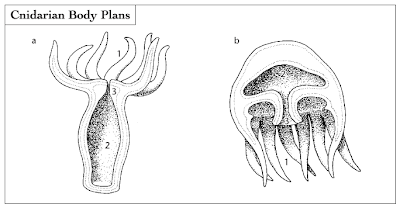Corals are the animals for which the coral reef is named and the primary architects of the system. Corals belong to a group of organisms called cnidarians, which contains some of the most beautiful and colorful animals on Earth. Hydrozoans, sea fans, anemones, and jellyfish are also cnidarians.
All cnidarians have a similar body plan, even though their bodies occur in two forms: a vase-shaped polyp or a bellshaped medusa. As detailed in Figure below, in both cases the body is a simple saclike structure with one opening, which is called a mouth. The sac is made of two cell layers, the epidermis and endodermis. Lying between them is the mesoglea.
Cnidarians are more complex than sponges. They have a network of nerves running through their bodies that enable them to respond to stimuli. If a cnidarian is touched, the nerve net relays a message to other cells, signaling them to contract and move away from the stimulus. The nerve net also helps a cnidarian locate, capture, and consume food.
Cnidarians are named for a type of specialized cell, the cnidocyte, that is unique to this group. Cnidocytes are stinging cells located in tentacles and used for protection and capturing prey. Each cnidocyte contains a nematocyst, a harpoonlike structure on a long filament.
When something brushes against the cnidocyte, nerves send signals to the nematocyst triggering it to uncoil and extend the filament. In some species, filaments are tipped with barbs for injecting poison. In others, they are coated with a sticky material that holds prey. Once prey is snared, tentacles move it through the cnidarian’s mouth and into the gastrovascular cavity where enzymes break it down, and cells in the gut cavity absorb the nutrients. Undigested parts are expelled through the mouth.
Corals can reproduce sexually and asexually. Between the ages of seven and 10 years, polyps become sexually mature and capable of forming male and female reproductive cells. Depending on the species, eggs may be fertilized internally or externally. Each zygote that results from fertilization develops into a small, swimming larva called a planula.
A planula is a ciliated larva about the size of the head of a pin that floats and swims some distance from its parents before settling. The larva attaches to a hard substrate and forms a polyp, never to move again. Once settled, a “founder” polyp starts making miniature copies of itself in the form of tiny buds that grow on all sides of the column. In this way, the original polyp begins a new colony of coral.
Corals blur the distinction between producers, consumers, and detritivores (organisms that feed on dead and decaying matter) because they use all three methods to meet their nutritional needs. This complex food plan helps corals survive by reducing their dependence on any one food source. Even if changes in the environment wipe out one supply of food, the corals have others on which they can fall back.
All corals are carnivores that can capture prey with their nematocyst-armed tentacles. Most species feed at night to avoid their own predators. In the dark, corals wave their tentacles in the water, waiting for small animals to swim within their reach.
Corals can also feed as detritivores. When levels of nutrients are high in the seawater, corals absorb dissolved organic matter (DOM) through their cell membranes. These molecules and compounds are used just like molecules from other food sources are, to meet energy needs and build cell structures. In addition, the tentacles of corals are coated with mucus so that tiny food particles that are floating in the water column will stick to them.
Many corals produce much of their own food with the help of zooxanthellae. Zooxanthellae are photosynthetic dinoflagellates that live within cells lining the gastrovascular cavity of coral. As zooxanthellae make their own food, some of it leaks into the coral host. Research on coral nutrition indicates that zooxanthellae meet the majority of coral nutritional needs.
Zooxanthellae perform another important job for the coral. The buildup of waste materials in an animal’s tissues can slow down its metabolism and growth. Many simple marine animals must depend on the process of diffusion into the surrounding water to carry away these wastes. Zooxanthellae actively take up the waste products of their coral hosts. These products are the raw ingredients that zooxanthellae need to carry out photosynthesis.


